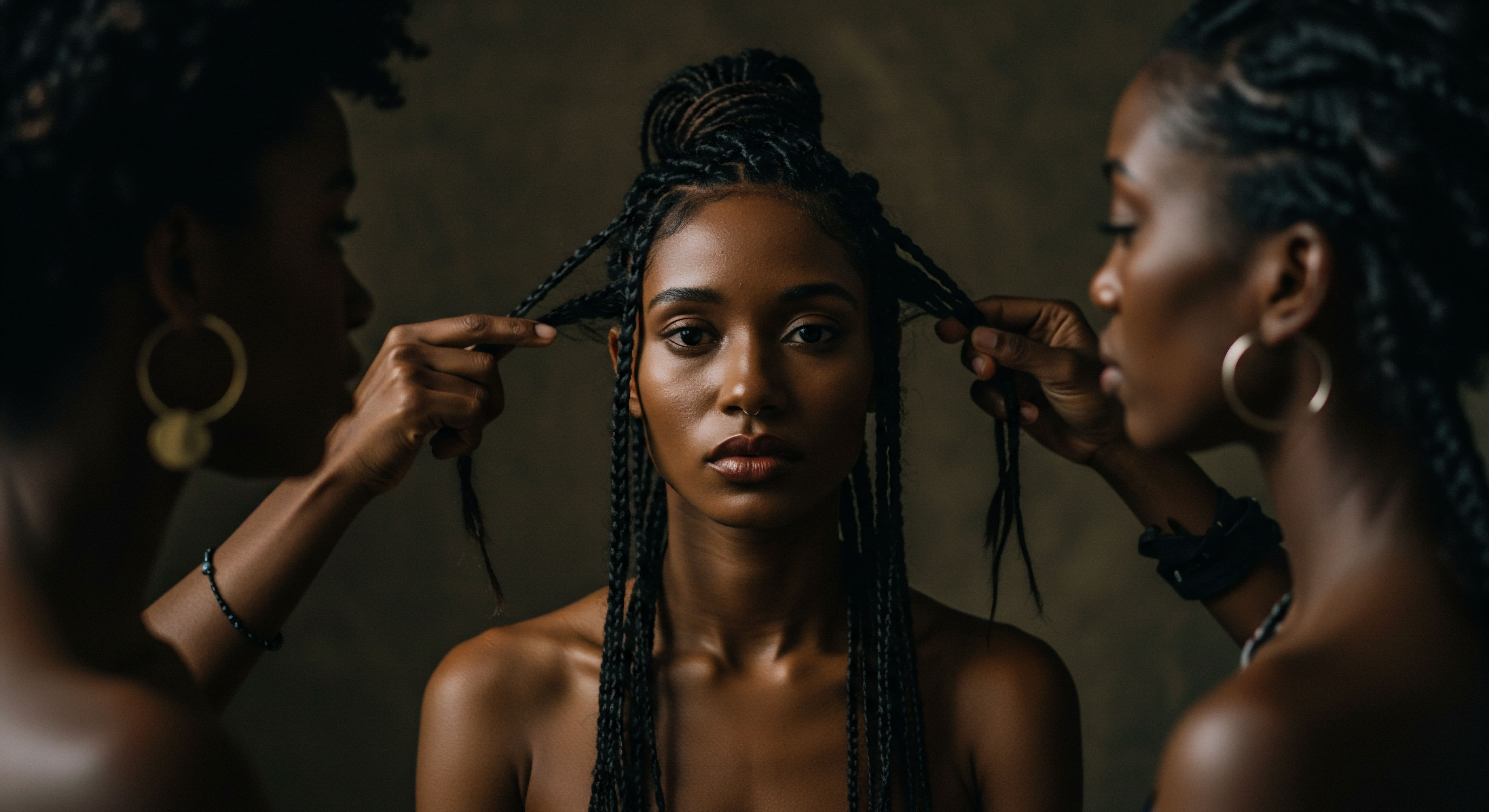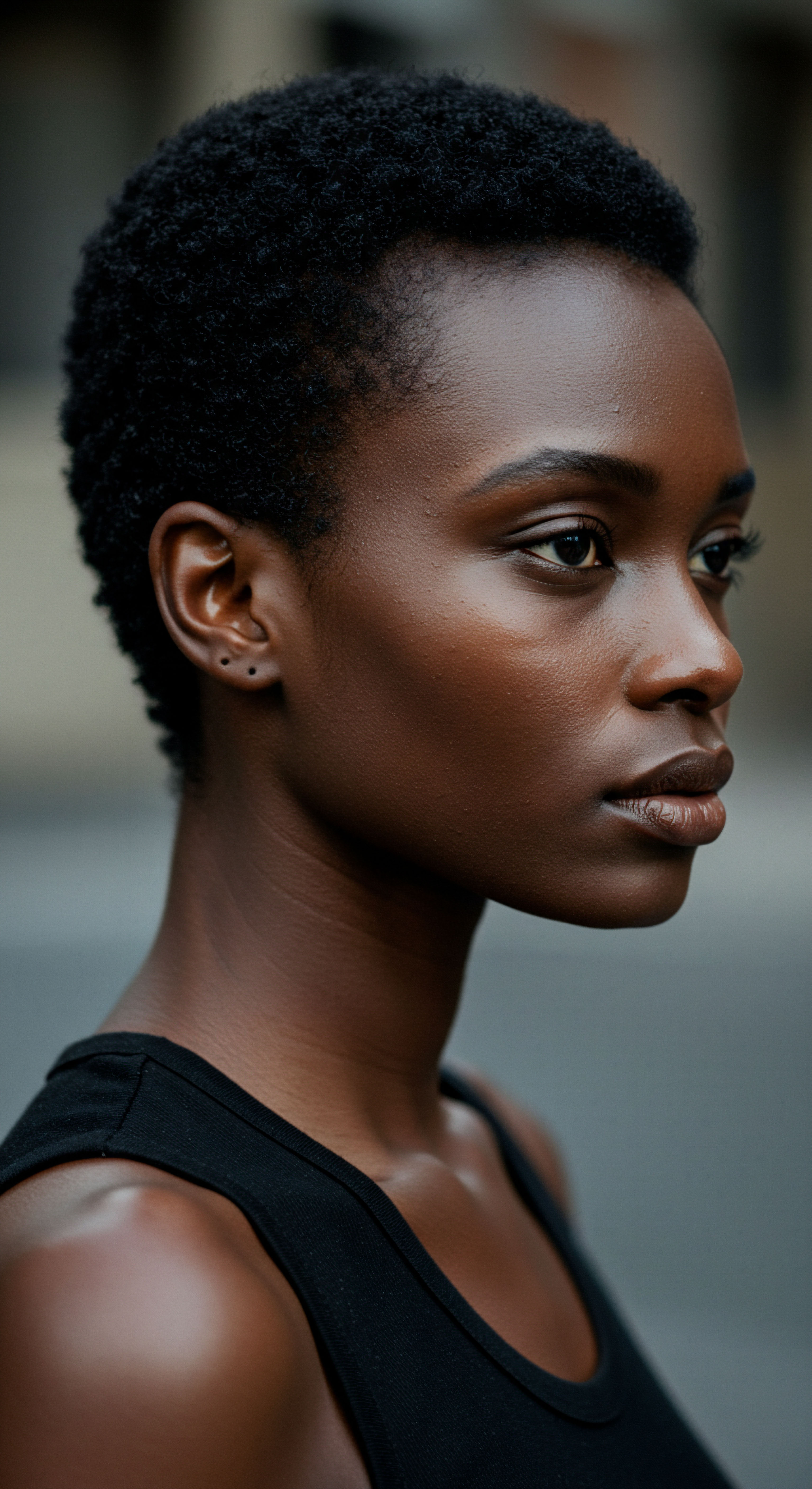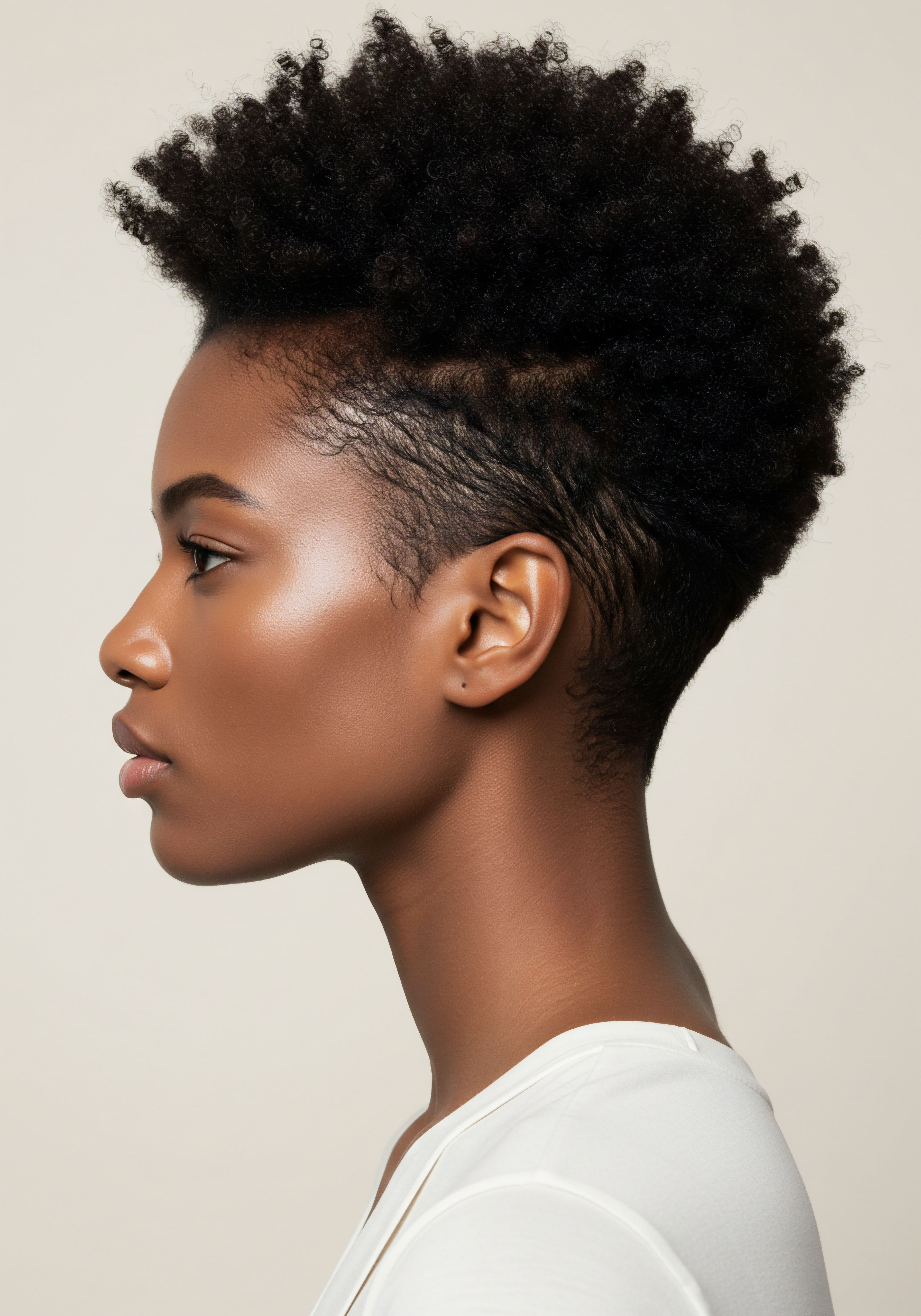
Roots
There is a quiet wisdom that whispers through the generations, a knowing touch that speaks of care and preservation. For those with textured hair, this wisdom often begins with the simple, yet profound, act of covering one’s hair. Before the modern bonnet found its place on nightstands, its spirit lived in the head coverings of ancient lands, serving not merely as adornment but as a testament to identity, status, and practical protection against the elements. This ancestral practice forms the very soil from which the contemporary bonnet has grown, a continuity of care that stretches back through time.

Ancient Practices Across African Lands
Across the diverse landscapes of pre-colonial Africa, hair held a sacred position. It was a canvas for communication, a marker of one’s standing within the community, signifying age, marital status, religious affiliation, and even wealth. Hairstyles were intricate, often requiring hours or even days to sculpt, incorporating natural materials such as clay, oils, herbs, shells, beads, and feathers.
These elaborate creations were not left exposed to the whims of the environment. Head wraps, known by names like Dukus in Ghana and Doek in Namibia, were integral to daily life, protecting these carefully constructed styles from dust, sun, and dirt, while also serving as powerful symbols of beauty and societal position.
In many African societies, head coverings were not just about practical utility or status; they carried deep spiritual meaning. Hair, considered the most elevated part of the body by some groups, was believed to hold magical powers and connect individuals to their ancestors and the divine. The act of covering one’s hair could be an act of respect, humility, or even a way to assert spiritual alignment. This rich cultural context meant that head coverings were far from mere accessories; they were extensions of self, steeped in tradition and meaning.

A Forced Uniform Transformed
The transatlantic slave trade marked a brutal rupture, tearing individuals from their homelands and systematically stripping them of their cultural practices. One of the first acts of dehumanization often involved shaving the heads of enslaved Africans, severing a profound connection to their heritage and identity. Stripped of their traditional tools, oils, and the time required for elaborate hair care, enslaved individuals faced immense challenges in maintaining their hair.
Under these harsh conditions, hair became matted, tangled, and often damaged. Simple head coverings, often made from scraps of fabric or cotton rags, became a grim necessity, initially serving as a means to obscure hair that could not be properly tended.
These coverings, which began as a symbol of forced subservience, were soon imbued with a defiant spirit. Black women, even in the face of oppression, began to reclaim these simple cloths. They found ways to express identity and subtle resistance through the choice of fabric, the way the cloth was tied, or even by concealing coded messages within the folds of their headscarves, communicating with one another in ways their enslavers could not comprehend. This act of transformation, turning a tool of control into an expression of resilience, is a poignant chapter in the history of hair coverings for Black women.
The bonnet’s story begins not in a single moment, but in the enduring wisdom of ancestral hair care practices.

The Tignon Laws
A stark illustration of this complex history is found in the Tignon Laws of 1786, enacted by Spanish Governor Esteban Rodríguez Miró in colonial Louisiana. These sumptuary laws mandated that free Black women, particularly those of mixed heritage known as Gens De Couleur Libres, cover their hair with a headscarf, or Tignon, in public. The intent was clear ❉ to visibly distinguish them from white women and to diminish their perceived attractiveness and social standing, which was seen as a threat to the established social order.
However, the women targeted by these laws responded with remarkable ingenuity. They transformed the mandated tignon into a powerful statement of style and resistance. Instead of plain kerchiefs, they donned head coverings made from the finest textiles, adorned with jewels, ribbons, and feathers, tied in elaborate and striking styles.
What was intended as a mark of subjugation became a mark of distinction, a vibrant display of cultural pride and an undeniable assertion of self. This historical defiance highlights how hair coverings, including the nascent bonnet, became deeply intertwined with self-expression and cultural identity in the African diaspora.

European Nightcaps and Their Shift
While the narrative of head coverings for Black women was evolving, European societies also utilized various forms of headwear for sleep. From the Middle Ages through the 19th century, nightcaps were common in Northern Europe, primarily for warmth in unheated homes. These caps varied in design; men often wore pointed hats, while women’s nightcaps might be a long piece of cloth wrapped around the head or a triangular cloth tied under the chin.
As homes became better insulated and fashions changed, the general use of nightcaps began to wane in European society. However, for Black women, the practice of covering hair at night continued and deepened, driven by distinct needs related to textured hair’s unique properties and the enduring legacy of hair care practices rooted in ancestral wisdom and the conditions of the diaspora. The protective function of these coverings gained increasing importance, laying the groundwork for the modern bonnet as a specialized tool for hair preservation.

Ritual
The journey from historical necessity to daily ritual is a subtle one, yet deeply felt. For those who care for textured hair, the act of preparing for sleep extends beyond winding down the day; it becomes a moment of intentional protection, a quiet pact with one’s strands. This section explores how the bonnet moved from a historical artifact to a cornerstone of nightly care, embodying a practical wisdom passed down through generations. We will delve into the precise techniques, the materials chosen, and the unspoken understanding that shapes this bedtime practice.

Why the Nighttime Pact
The unique structure of textured hair, characterized by its coils and curls, makes it inherently more susceptible to moisture loss and mechanical damage. Unlike straight hair, the natural oils produced by the scalp struggle to travel down the hair shaft of curly patterns, leading to drier strands. Additionally, the friction generated by movement against rough surfaces, such as cotton pillowcases, can cause the hair cuticle to lift, resulting in frizz, tangles, and breakage. This understanding, whether scientific or experiential, propelled the consistent practice of hair protection during sleep.
The bonnet became a primary defense against these nightly aggressors. It created a smooth, enclosed environment for the hair, minimizing contact with absorbent and abrasive fabrics. This simple covering acts as a guardian, helping to retain the hair’s natural moisture and preserving intricate styles, reducing the need for frequent restyling and the potential damage that comes with it. This practical application cemented the bonnet’s place as an indispensable tool in the textured hair care routine.

How Bonnets Preserve Hair Styles
The preservation of hairstyles stands as a key function of the bonnet. For individuals with textured hair, creating a defined style—be it braids, twists, or a set of curls—often requires significant time and effort. Sleeping without protection can undo this work in a single night, leading to flattened, frizzy, or tangled results.
- Minimizing Movement ❉ A bonnet holds the hair gently in place, preventing it from shifting and rubbing against itself or bedding.
- Maintaining Shape ❉ It helps curls and waves retain their definition, reducing the need for re-styling in the morning.
- Extending Longevity ❉ By shielding styles from friction and environmental factors, bonnets extend the life of protective styles, reducing the frequency of manipulation.
This ability to extend the life of a style offers not only convenience but also contributes to overall hair health by reducing the mechanical stress of daily styling.
The nightly donning of a bonnet transcends simple habit, becoming a deliberate act of self-care and hair preservation.

The Tactile Difference of Fabrics
The choice of fabric for a bonnet is a critical element in its effectiveness. While early coverings might have been made from any available material, the preference for smooth, non-absorbent fabrics like silk and satin emerged from direct experience and a growing understanding of hair’s needs.
| Fabric Type Cotton |
| Surface Texture Rough, fibrous |
| Moisture Absorption High (absorbent) |
| Friction Level High |
| Impact on Hair Increased frizz, dryness, breakage |
| Fabric Type Satin |
| Surface Texture Smooth, silky (synthetic or blend) |
| Moisture Absorption Low |
| Friction Level Low |
| Impact on Hair Reduced frizz, moisture retention, less breakage |
| Fabric Type Silk |
| Surface Texture Smooth, naturally soft (protein fiber) |
| Moisture Absorption Very Low |
| Friction Level Very Low |
| Impact on Hair Optimal frizz reduction, superior moisture retention, minimal breakage |
| Fabric Type Choosing satin or silk significantly improves nighttime hair protection. |
Satin, often a blend of synthetic fibers, provides a smooth surface that allows hair to glide, minimizing friction. Silk, a natural protein fiber, offers an even more gentle surface, creating an environment where hair cuticles remain flat and undisturbed. The smooth surface of these materials helps prevent the mechanical damage that leads to frizz and split ends, while their non-absorbent nature helps hair retain its natural oils and applied products. This material science, refined through generations of practical use, underscores the bonnet’s effectiveness.

Community Knowledge and Transmission
The knowledge surrounding bonnets and protective nighttime hair care was not typically disseminated through formal education or written manuals in its early stages. Instead, it was a living tradition, passed down through the intimate spaces of family and community. Mothers taught daughters, aunts guided nieces, and friends shared insights.
These lessons were often interwoven with the daily rhythms of life, learned through observation and hands-on experience. The communal aspect of hair care, a practice often shared and discussed, reinforced the importance of these rituals.
This oral tradition, rich with anecdotal wisdom and practical tips, ensured the continuity of protective hair practices. The bonnet became a quiet symbol of this shared heritage, a tangible link to the collective knowledge of how to care for textured hair in a world that often misunderstood or undervalued its unique needs. This communal passing of wisdom speaks to the enduring strength and adaptability of cultural practices within the African diaspora.

Relay
Beyond its tangible presence, what deeper currents does the bonnet carry through time? Its story extends beyond mere fabric and function, delving into the very science of hair, the intricate psychology of identity, and the enduring power of cultural continuity. This section ventures into the more complex dimensions of the bonnet’s significance, exploring how this unassuming accessory serves as a vital relay of heritage, resilience, and scientific understanding.

What Does Hair Friction Mean for Textured Hair?
At a microscopic level, textured hair possesses a unique architecture that makes it particularly vulnerable to friction. The coils and bends of each strand mean that hair rubs against itself and external surfaces more frequently than straight hair. This constant mechanical action can lift the outermost protective layer of the hair, known as the Cuticle. When the cuticle scales are raised, the hair becomes rougher, leading to increased tangling, frizz, and ultimately, breakage.
The consequence of this friction is not trivial. For individuals with textured hair, everyday activities, especially sleeping on common pillowcases, can contribute to cumulative damage. A smooth surface, such as that offered by silk or satin, drastically reduces this friction. Research underscores this benefit ❉ a study highlights that Silk Bonnets Reduce Hair Breakage by up to 43% compared to cotton alternatives over an eight-week testing period.
This significant reduction in damage extends the hair’s life, promotes length retention, and preserves its inherent strength. This scientific validation grounds the traditional practice in demonstrable fact.

How Has the Bonnet Become a Symbol of Self-Worth?
The bonnet’s journey from a tool of oppression to a symbol of self-worth is a testament to the resilience of Black women. During periods of enslavement and beyond, when Black hair was often denigrated and policed, the act of protecting one’s hair became a quiet, yet powerful, assertion of dignity. The bonnet, initially a forced covering, transformed into a personal shield, guarding not only hair but also the spirit.
In contemporary society, the bonnet carries layers of meaning. It represents a conscious choice to prioritize hair health over external pressures, a rejection of Eurocentric beauty standards that historically devalued textured hair. Wearing a bonnet, especially in public spaces, can be a defiant act, signaling a deep self-acceptance and pride in one’s natural hair. It speaks to a heritage of self-preservation and a refusal to conform, embodying a personal revolution in beauty.
The bonnet, in its quiet utility, carries a powerful legacy of defiance and self-affirmation.

What Role Do Bonnets Play in Cultural Continuity?
The bonnet is more than a practical item; it serves as a tangible link across generations, a living artifact of cultural continuity. Its consistent presence in the lives of Black women, from childhood lessons on hair care to adult routines, connects them to their ancestors who first adapted head coverings for protection and expression. This continuity ensures that practices, knowledge, and values related to textured hair care are passed down, maintaining a vital connection to heritage.
The shared experience of wearing a bonnet, the collective understanding of its purpose and meaning, strengthens communal bonds. It is a quiet language spoken between those who understand the unique needs and historical context of textured hair. This shared ritual reinforces a sense of collective identity, a powerful reminder of shared history and ongoing cultural vibrancy.
This enduring practice also shapes economic realities. The growing market for satin and silk bonnets reflects a broader recognition of the specific needs of textured hair. This demand, driven by generations of practical knowledge, supports businesses that cater to these needs, reinforcing the economic value of cultural practices.

The Bonnet in Modern Contexts
Today, the bonnet exists in a complex interplay of practicality, fashion, and social commentary. While its primary role remains hair protection, it has also entered the realm of public discourse, sparking conversations about appearance, comfort, and societal expectations. The decision to wear a bonnet outside the home often becomes a statement, challenging preconceived notions of what is considered “appropriate” or “presentable.”
The rise of natural hair movements has further solidified the bonnet’s standing. As more individuals embrace their natural textures, the need for effective protective measures, especially during sleep, becomes even more apparent. The bonnet stands as a testament to the ongoing evolution of textured hair care, a blend of ancient wisdom, scientific understanding, and contemporary self-expression. Its continued presence highlights a commitment to health, heritage, and the unapologetic celebration of natural beauty.
This accessory also finds its place in broader fashion discussions. While some view public bonnet wear as a casual choice, others see it as a powerful assertion of comfort and authenticity. The dialogue around the bonnet in public spaces reflects a wider conversation about beauty standards, personal freedom, and the right to define one’s own appearance without external judgment.
| Era Pre-Colonial Africa |
| Purpose/Significance Status, identity, spiritual connection, protection from elements. |
| Context Traditional attire, cultural markers, part of elaborate hairstyles. |
| Era Slavery Era |
| Purpose/Significance Forced uniform, dehumanization, covert resistance, hair protection. |
| Context Enforced by enslavers, reclaimed by enslaved women for identity and communication. |
| Era Post-Slavery / Tignon Laws |
| Purpose/Significance Legal subjugation, defiance, fashion statement. |
| Context Laws like the Tignon Laws in Louisiana attempted to control Black women's appearance; they responded with elaborate, defiant styles. |
| Era Early 20th Century |
| Purpose/Significance Practical hair maintenance, preserving styles. |
| Context Emergence of hair care products, bonnet as a tool for sustaining treated and natural textures. |
| Era Civil Rights & Black Power Era |
| Purpose/Significance Symbol of pride, cultural reclamation, defiance. |
| Context Headwraps and bonnets adopted as statements against Eurocentric norms. |
| Era Contemporary |
| Purpose/Significance Daily protective tool, personal comfort, cultural statement, self-acceptance. |
| Context Mainstay of textured hair care, visible in public, sparks dialogue on beauty standards. |
| Era The bonnet's history is a continuum of adaptation and cultural meaning. |

Reflection
The humble bonnet, often seen as a simple nighttime accessory, holds within its soft folds a profound and layered history. It stands as a silent witness to centuries of adaptation, resilience, and the unwavering commitment to self-preservation. From the vibrant expressions of identity in ancient African lands to the forced coverings of enslavement, and from the defiant artistry of the Tignon era to its scientific validation in modern hair care, the bonnet’s journey mirrors the complex and powerful story of textured hair itself. It is a testament to how practical solutions can evolve into enduring symbols, carrying forward a legacy of care, resistance, and undeniable beauty.

References
- Byrd, Ayana, and Lori Tharps. Hair Story ❉ Untangling the Roots of Black Hair in America. St. Martin’s Press, 2001.
- Cobb, Jasmine Nichole. New Growth ❉ The Art and Texture of Black Hair. Duke University Press, 2023.
- Dabiri, Emma. Twisted ❉ The Tangled History of Black Hair Culture. Harper Perennial, 2020.
- McMullen, Roger L. “Physicochemical Properties of Textured Hair.” Journal of Cosmetic Science, vol. 72, no. 6, 2022, pp. 711-731.
- Oforiwa, Alice. “The History and Culture of African Natural Hair ❉ From Ancient Times to Modern Trends.” AMAKA Studio, 2023.
- Ruetsch, S. B. et al. “Cuticular damage to African-American hair during relaxer treatments—A microfluorometric and SEM study.” IFSCC Magazine, vol. 11, 2008, pp. 131-137.
- Walker, Madam C.J. Text Book of the Madam C.J. Walker Schools of Beauty Culture.